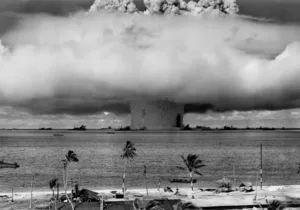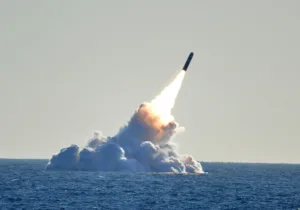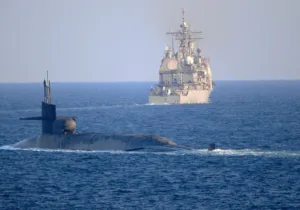Once again, the subject of nuclear weapons is in the news. The president’s sometimes inelegant talk about “nuclear buttons”—the United States’ button being “bigger” than that of North Korea’s, of course—and his refusal to allow North Korea’s nuclear tests to go unanswered have even elicited Senate hearings on the process by which the president can order nuclear attack. President Trump has insisted that “the United States must greatly strengthen and expand its nuclear capability until such time as the world comes to its senses regarding nukes,” and that too has riled his critics.
It is within this context that the Trump administration just released the nation’s new nuclear deterrence strategy blueprint, called the “Nuclear Posture Review” (NPR). It is a serious, careful, and entirely reasonable document. The strategy even complements the president’s tough talk about the U.S. nuclear deterrent.
Secretary of Defense James Mattis will defend the report before the House Armed Services Committee this Tuesday, February 6, and no doubt it will be worth watching.
Here are three themes the secretary will likely address on Tuesday:
First, like the National Security Strategy (NSS) and National Defense Strategy (NDS), the NPR recognizes that China and Russia are engaged in “great power competition.”
Threats by North Korea and Iran remain serious, and in the case of North Korea near imminent. The possibility that terrorists could get their hands on a nuclear weapon also remains a threat the U.S. government takes seriously and is working to combat.
But as the Trump National Security Strategy recognized, Russia continues to “challenge American power, influence, and interests, attempting to erode American security and prosperity.” China, and especially Russia, are challenging the United States while brandishing nuclear weapons. The NPR responds to this reality.
By contrast, the 2010 Obama NPR was based on the assumption that, while Russia remains a nuclear peer, “Russia and the United States are no longer adversaries, and prospects for military confrontation have declined dramatically.”
The last Russian National Security Strategy labeled NATO a threat, and Russian behavior supports Moscow’s view that NATO is the enemy. Russian officials have threatened to attack U.S. defensive deployments in NATO countries, have openly threatened nuclear attack, have increased the number of incursions into NATO and U.S. airspace, and have strongly opposed any kind of U.S. effort to deploy defensive systems in Central Europe against Iranian missiles. Russia’s military build-up, deployments, and massive military exercises on its borders understandably have NATO allies on edge.
Most concerning, Russia is amid a major nuclear modernization effort, and Russia’s nuclear doctrine has lowered the threshold for when Russia might consider employing nuclear weapons.
The threats, the military investments and drills, and the airspace incursions are cause enough to take the threat seriously, but Russia’s willingness to make good on its threats is especially credible considering Russia’s invasion of Ukraine in 2014.
Second, the supplements included in the NPR do not lower the U.S. threshold for when we might consider launching a nuclear attack; rather, they raise the nuclear threshold for when our adversaries might launch an attack against U.S. vital interests.
The current U.S. nuclear deterrent appears to have a gap in it; otherwise, adversaries would have behaved differently. For example, the Russians refused to include nonstrategic nuclear weapons in the last arms control agreement with the United States. (Nonstrategic or “tactical” nuclear weapons have shorter ranges and usually smaller yields.) The Russians continue to invest in these nonstrategic options and in fact have roughly 10 of them for every NATO/U.S. nonstrategic nuclear weapon. The nonstrategic nuclear weapons that the NATO alliance does have are not in a sufficient state of readiness to pose a credible deterrent.
The Trump NPR offers supplements to the current U.S. nuclear deterrent in the form of two low-yield sea-based options. One is to provide the submarine launch ballistic missiles (SLBM) with a lower-yield nuclear warhead option. This is a very low-cost change that can equip the SLBMs in the near term. The other supplement will come in the form of a sea-based nuclear cruise missile (SLCM). The United States had the SLCM until 2010, at which point we retired it. The Russians continue to violate the 1987 Intermediate-Range Nuclear Forces (INF) Treaty, which eliminated ground-launched cruise missiles with a range between 500 and 5,500 kilometers. Bringing back the SLCM at least offers the possibility of demonstrating to the Russians they can’t violate treaties without consequence, and it does this without the U.S. disbanding the treaty altogether. In other words, the supplements actually bolster current arms control treaties. In the words of President Obama: “Rules must be binding. Violations must be punished. Words must mean something.”
Also, the Trump NPR does not rule out the possibility that the United States might be willing to employ nuclear weapons in response to a non-nuclear attack if that attack was against U.S. “vital interests.” It states:
The United States would only consider the employment of nuclear weapons in extreme circumstances to defend the vital interests of the United States, its allies, and partners. Extreme circumstances could include significant non-nuclear strategic attacks. Significant non-nuclear strategic attacks include, but are not limited to, attacks on the U.S., allied, or partner civilian population or infrastructure, and attacks on U.S. or allied nuclear forces, their command and control, or warning and attack assessment capabilities.
This merely makes the Obama NPR’s statement a bit clearer. It explicitly reserved the right to respond to non-nuclear attacks with nuclear weapons.
Third, the cost of the Trump plan for the U.S. nuclear deterrent is completely affordable. In fact, we cannot afford not to pay the price necessary to make it as credible as possible.
Critics of the modernization plan, not typically known for their concern for government fiscal responsibility in any other area of federal spending, often denounce the nuclear enterprise as cost-prohibitive. This is nonsense. The Obama administration even admitted it was affordable, and Secretary of Defense Ash Carter was one of the most persuasive defenders of its affordability.
As the Trump NPR shows, modernization of our nuclear deterrent will cost between 6-7 percent of the entire defense budget. Furthermore, as the NPR makes clear: “The projected DoD costs of sustaining and replacing the nuclear capabilities needed to support U.S. national security strategy, while substantial, are moderate in historical terms and represent a small fraction of the DoD budget.” In 1962 the cost was 17.1 percent, for comparison.
Nuclear deterrence prevents the worst kinds of war. And, as Secretary Mattis has said, “America can afford survival.”
The United States must be able to convince our adversaries that Americans have the will and capability to inflict punishment on them in response to an act of aggression such that they would not carry out the act of aggression in the first place, and so the United States won’t have to inflict the punishment it promises. As the security environment increasingly demonstrates, adversaries are beginning to doubt the credibility of that American promise, and the new NPR seeks to change that.
—
Rebeccah L. Heinrichs, a contributing editor at Providence, is a fellow at Hudson Institute where she provides research and commentary on a variety of international security issues and specializes in deterrence and counter-proliferation. She is also the vice-chairman of the John Hay Initiative’s Counter-proliferation Working Group and the original manager of the House of Representatives Bi-partisan Missile Defense Caucus.
Be sure to read Heinrichs’ “A Robust Nuclear Deterrent: A Force for Peace & Justice” from the Winter 2016 issue of Providence‘s print edition, in which she explains why the U.S. should have nuclear weapons from a Christian perspective.
Photo Credit: An unarmed Minuteman III intercontinental ballistic missile launches during an operational test on August 2, 2017, at Vandenberg Air Force Base, Calif. U.S. Air Force photo by Senior Airman Ian Dudley.






